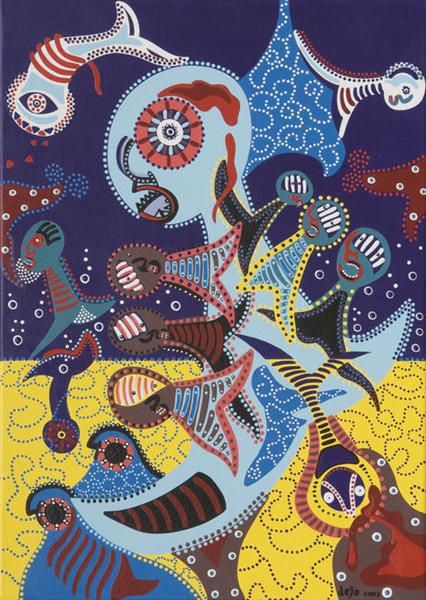
Toyism
Art movement
Toyism is a contemporary art movement that originated in the 1990s in Emmen. The word symbolises the playful character of the artworks and the philosophy behind it. The suffix ‘ism’ refers to motion or movements that exist in both the world of art and religion. Nevertheless, the game of Toyism is a serious matter that shows a new, critical and sensitive perspective on our present-day world.
Toyism as art movement is a reaction on the post-modern world of individualism, which existed in the 1970s through the 1990s, the era in which “everything is allowed”. The name originated in 1990 when Toyist Dejo made a graphic work which was titled "Escape of computer spiders " . It was this work and later similar works that were the origin of the style at the beginning of the nineties. However, it took another two years before this resulted in a manifest. On September the 5th 1992 artist and musician Dejo (pseudonym) from Emmen writes a manifesto called Mother and introduces Toyism to the audience.
Toyism can be split in two different periods, the period 1992 until 2000 and 2002 until the present.
A couple of months after the manifesto was written, two other artists form Emmen joined the movement. In the first period mostly the themes were worked out in a surrealistic manner and the returning presence of fixed icons (computer, space shuttle and teddy-bear) in their paintings. These icons represented the attending artists. The first exhibition was on February 24, 1993 in Het Veenpark. One year after the foundation work was exhibited in New York City. At the base was a figurative style with uniform areas of colour and simplistic elements that where inspired by Super Mario and the game console Nintendo. After the triumvirate fell apart, founder Dejo decided to make a world-trip and gets inspired to make Toyism more international and open.
After his world-trip Dejo rewrote the manifesto and gave other artists access to join the movement. As from 2002 the group of artists grows exponentially and artists from every corner of the earth decide to participate (Thailand, South Africa, Malaysia, United States, Iceland, Mexico, Peru, Italy, Australia, Canada, Belgium, the Netherlands, Romania).
Present day the toyists have created 777 works of art, varying from paintings to sculptures and buildings. The toyists had a permanent studio/gallery in Emmen until 2015. In the same year they relocated their headquarters to the city of Groningen. They now have a gallery in Villa Heymans next to the Groninger Museum.
The philosophy of Toyism is that the artists operate as a collective, instead of separate individuals, hence one toyist cannot be seen as more important or famous than the other. There is no rivalry among the artists. The evident message they carry out is that the artworks count, not the artist itself that has created it. Although the artists do make their own art, in many occasions the toyists work together, which means that the produced artwork cannot be attributed to a single artist.
The secret manifesto Mother contains a palette of ingredients from which mainly paintings, but lately also sculptures, silkscreens, jewelry and glass art emerge. The manifesto is only meant to be read by the attending artists. The artworks can be seen as children of Mother and one or more parents (the artists). A parent can be either a man or a woman, or even more artists representing one parent next to Mother. This can be established because of the anonymous characteristics of the parents, they operate by using a pseudonym hiding their real identity for the audience. Every parent mixes ideas and characteristics with properties of Mother. This strongly connects the children, after all they arose from Mother.
This is a part of the Wikipedia article used under the Creative Commons Attribution-Sharealike 3.0 Unported License (CC-BY-SA). The full text of the article is here →
Wikipedia: https://en.wikipedia.org/wiki/Toyism